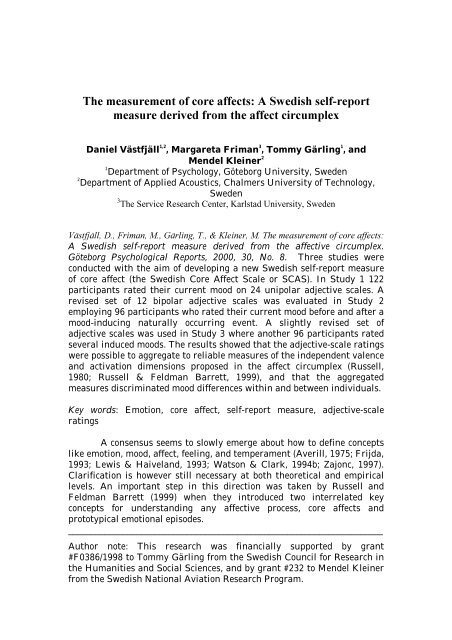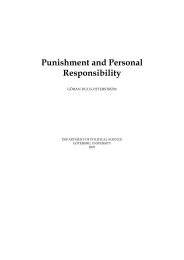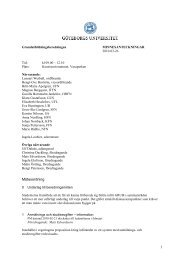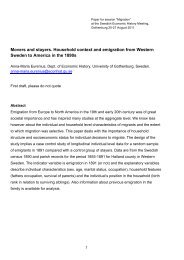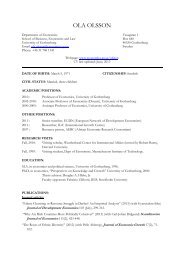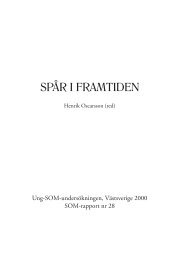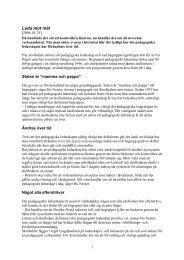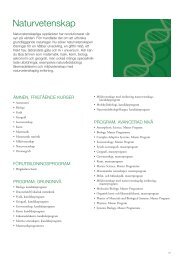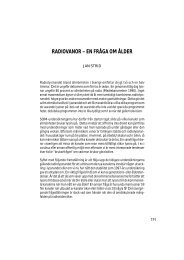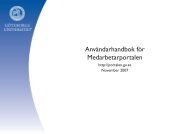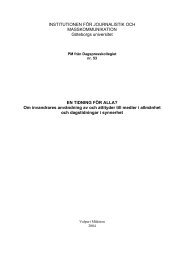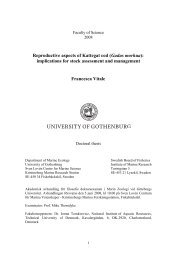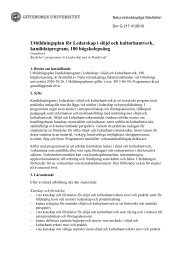The measurement of core affects: A Swedish self report measure ...
The measurement of core affects: A Swedish self report measure ...
The measurement of core affects: A Swedish self report measure ...
You also want an ePaper? Increase the reach of your titles
YUMPU automatically turns print PDFs into web optimized ePapers that Google loves.
7KHPHDVXUHPHQWRIFRUHDIIHFWV$6ZHGLVKVHOIUHSRUW<br />
PHDVXUHGHULYHGIURPWKHDIIHFWFLUFXPSOH[<br />
Daniel Västfjäll 1,2 , Margareta Friman 3 , Tommy Gärling 1 , and<br />
Mendel Kleiner 2<br />
1<br />
Department <strong>of</strong> Psychology, Göteborg University, Sweden<br />
2<br />
Department <strong>of</strong> Applied Acoustics, Chalmers University <strong>of</strong> Technology,<br />
Sweden<br />
3 <strong>The</strong> Service Research Center, Karlstad University, Sweden<br />
9lVWIMlOO')ULPDQ0*lUOLQJ7 .OHLQHU07KHPHDVXUHPHQWRIFRUHDIIHFWV<br />
A <strong>Swedish</strong> <strong>self</strong>-<strong>report</strong> <strong>measure</strong> derived from the affective circumplex.<br />
Göteborg Psychological Reports, 2000, 30, No. 8. Three studies were<br />
conducted with the aim <strong>of</strong> developing a new <strong>Swedish</strong> <strong>self</strong>-<strong>report</strong> <strong>measure</strong><br />
<strong>of</strong> <strong>core</strong> affect (the <strong>Swedish</strong> Core Affect Scale or SCAS). In Study 1 122<br />
participants rated their current mood on 24 unipolar adjective scales. A<br />
revised set <strong>of</strong> 12 bipolar adjective scales was evaluated in Study 2<br />
employing 96 participants who rated their current mood before and after a<br />
mood-inducing naturally occurring event. A slightly revised set <strong>of</strong><br />
adjective scales was used in Study 3 where another 96 participants rated<br />
several induced moods. <strong>The</strong> results showed that the adjective-scale ratings<br />
were possible to aggregate to reliable <strong>measure</strong>s <strong>of</strong> the independent valence<br />
and activation dimensions proposed in the affect circumplex (Russell,<br />
1980; Russell & Feldman Barrett, 1999), and that the aggregated<br />
<strong>measure</strong>s discriminated mood differences within and between individuals.<br />
Key words: Emotion, <strong>core</strong> affect, <strong>self</strong>-<strong>report</strong> <strong>measure</strong>, adjective-scale<br />
ratings<br />
A consensus seems to slowly emerge about how to define concepts<br />
like emotion, mood, affect, feeling, and temperament (Averill, 1975; Frijda,<br />
1993; Lewis & Haiveland, 1993; Watson & Clark, 1994b; Zajonc, 1997).<br />
Clarification is however still necessary at both theoretical and empirical<br />
levels. An important step in this direction was taken by Russell and<br />
Feldman Barrett (1999) when they introduced two interrelated key<br />
concepts for understanding any affective process, <strong>core</strong> <strong>affects</strong> and<br />
prototypical emotional episodes.<br />
_____________________________________________________________________<br />
Author note: This research was financially supported by grant<br />
#F0386/1998 to Tommy Gärling from the <strong>Swedish</strong> Council for Research in<br />
the Humanities and Social Sciences, and by grant #232 to Mendel Kleiner<br />
from the <strong>Swedish</strong> National Aviation Research Program.
No. 8:30,2<br />
<br />
A prototypical emotional episode is an experienced or anticipated<br />
chain <strong>of</strong> events (e.g., Lazarus, 1991) consisting <strong>of</strong> antecedents, appraisals,<br />
physiological, affective, and cognitive changes, and behavioral responses.<br />
Prototypical emotional episodes constitute a finite discrete set that can be<br />
enumerated and described. Examples include surprise, disappointment,<br />
anger, disgust, fear, and happiness (Ekman, 1993).<br />
Core <strong>affects</strong> are cognitively accessible elements <strong>of</strong> a current mood, an<br />
emotional reaction, or an anticipated emotional reaction. <strong>The</strong>y are present<br />
at any given time, even at a neutral level. Numerous studies have been<br />
performed to investigate the structure <strong>of</strong> <strong>core</strong> <strong>affects</strong>.<br />
It was suggested early that <strong>core</strong> <strong>affects</strong> can be described by a set <strong>of</strong><br />
underlying dimensions. For instance, Wundt (1924) concluded from<br />
introspection <strong>of</strong> affective reactions to auditory rhythms that three<br />
dimensions may account for all possible differences between affective<br />
states: pleasure-displeasure, strain-relaxation, and excitement-calmness.<br />
Later Schlosberg (1952, 1954) proposed an additional dimension<br />
corresponding to sleep-tension. However, more recent evidence from<br />
judgments <strong>of</strong> similarity between emotion adjectives (Block, 1957; Bush,<br />
1973; Russell, 1978, 1979; Reisenzein, 1994), judgments <strong>of</strong> facially<br />
expressed emotions (Russell & Bullock, 1985), <strong>self</strong>-<strong>report</strong>ed mood<br />
(Feldman, 1995a, 1995b, 1996; Mayer & Gaschke, 1988; Meyer & Schack,<br />
1989; Morgan & Heise, 1988; Russell & Steiger, 1982; Watson, Clark &<br />
Tellegen, 1984), and psychophysiological <strong><strong>measure</strong>ment</strong>s (Cacioppo,<br />
Gardner, & Berntson, 1999: Lang, 1995; Lang, Bradley, & Cuthbert, 1990;<br />
Lang et al., 1993) suggests that two dimensions are sufficient.<br />
In two-dimensional models, <strong>core</strong> <strong>affects</strong> are organized in a circular or<br />
circumplex structure (Russell, 1980). Four such models have been<br />
proposed (Carroll, et al., 1999; Yik, Russell, & Feldman Barrett, 1999):<br />
Russell´s affect circumplex (Russell, 1980; see also Feldman Barrett &<br />
Russell, 1998, for a revised model), Watson and Tellegen´s (1985) positivenegative<br />
affect circumplex, Larsen and Diener´s (1992) eight octant<br />
circumplex, and Thayer´s (1987) tense and energetic activation<br />
dimensions. Larsen and Diener (1992) (see also Browne, 1992; Fabrigar,<br />
Visser, & Browne, 1997) noted that circumplex models imply (i) that<br />
<strong>affects</strong> vary in their degree <strong>of</strong> similarity to one another with respect to two<br />
underlying dimensions, and (ii) that <strong>affects</strong> are more or less evenly spaced<br />
around the circumference <strong>of</strong> the circumplex rather than being grouped<br />
together in clusters.<br />
Russell (1980) suggested that the two main affect dimensions or<br />
axes reflect degrees <strong>of</strong> pleasantness-unpleasantness and arousal. In<br />
support <strong>of</strong> this suggestion, participants tended to arrange eight affect<br />
categories, excitement, pleasure, contentment, sleepiness, depression,<br />
misery, distress, and arousal in a circular order with axes corresponding to<br />
pleasure-misery and aroused-sleepy at right angles to each other and<br />
secondary axes at 45 degrees corresponding to excitement-depression and
No. 8:30,3<br />
contentment-distress. In addition, factor analysis <strong>of</strong> <strong>self</strong>-<strong>report</strong> ratings <strong>of</strong><br />
mood on adjective scales revealed a pleasure-displeasure and an arousal<br />
dimension. In the most recent version <strong>of</strong> the affect circumplex (Russell &<br />
Feldman Barrett, 1999), the dimensions are labeled valence and<br />
activation.<br />
In an alternative circumplex model, Watson and Tellegen (1985)<br />
labelled the two dimensions positive affect (PA) and negative affect (NA).<br />
PA reflects pleasurable engagement with the environment and is<br />
characterized by <strong>affects</strong> such as euphoric, peppy, and elated, implying a<br />
combination <strong>of</strong> valence and activation. NA includes distressing and<br />
unpleasant affective states such as anxiety and anger, suggesting high<br />
activation and high unpleasantness. <strong>The</strong> PANAS mood scales (Watson,<br />
Clark & Tellegen, 1988) were derived from Watson and Tellegen´s (1985)<br />
circumplex model. <strong>The</strong> model can however be criticized on several grounds<br />
(Larsen & Diener, 1992). "Positive affect" and "negative affect" are<br />
misleading labels because low values <strong>of</strong> positive affect are experienced as<br />
unpleasant states and low values <strong>of</strong> negative affect as pleasant. Later<br />
Watson and Clark (1994a) extended the original PANAS scales to cover<br />
the full circumplex with both high and low values on the two dimensions.<br />
<strong>The</strong>y also renamed the dimensions as negative and positive activation<br />
(Watson et al. 1999; Watson & Tellegen, 1999). A suggestion is therefore<br />
that the PA/NA dimensions are rotated 45 degrees relative to the valence<br />
and activation axes (Russell & Feldman Barrett, 1999).<br />
Two additional models are Thayer´s (1986) energetic-tensed arousal<br />
dimensions and Larsen and Diener´s (1992) eight octant circumplex. In<br />
contrast to Russell (1980), Thayer (1986, 1989) concluded that two<br />
dimensions are needed to account for the activation dimension, energetic<br />
arousal and tense arousal. High markers <strong>of</strong> the energetic dimension<br />
include energetic, carefree, and elated, while low markers include tired<br />
and sluggish. High markers <strong>of</strong> the tense dimension are tense, intense, and<br />
anxious, while low markers are still and calm. It thus seems as if the<br />
energetic dimension largely corresponds to the PA dimension, the tense<br />
arousal dimension to the NA dimension <strong>of</strong> Watson and Tellegen (1985). In<br />
fact, research focusing on only one dimension, either valence (Lykken &<br />
Tellegen, 1996; Watson & Tellegen, 1985) or activation (Thayer, 1986),<br />
does not find a single dimension <strong>of</strong> affect but rather the combination <strong>of</strong> the<br />
two fundamental dimensions <strong>of</strong> activation and valence (Yik et al., 1999).<br />
Furthermore, the framing <strong>of</strong> dimensions as either valence (positive or<br />
negative affect) or activation (tense and energetic arousal) seems arbitrary<br />
in that the dimensions overlap, and in that they reflect combinations <strong>of</strong><br />
valence and activation.<br />
<strong>The</strong> four proposed models <strong>of</strong> affect structure (Larsen & Diener,<br />
1992; Russell, 1980; Thayer, 1986; 1989; Watson & Tellegen, 1985) thus<br />
appear to be interchangeable. Indeed, several researchers assume that the<br />
models are rotational variants (Burke et al., 1989; Lang, 1995; Mano,<br />
1992). In support <strong>of</strong> this, a recent study (Yik et al., 1999) found a<br />
substantial empirical overlap between the four models.
No. 8:30,4<br />
In summary, valence and activation appear to be necessary and<br />
sufficient to describe the structure <strong>of</strong> <strong>core</strong> <strong>affects</strong>. As shown in Figure 1,<br />
the intermediate dimensions <strong>of</strong> positive affect, energetic arousal, or<br />
activated pleasant affect-deactivated unpleasant affect will be referred to<br />
as pleasant activation-unpleasant deactivation, whereas the intermediate<br />
negative affect, tense arousal, or activated unpleasant affect-deactivated<br />
pleasant affect will be referred to as unpleasant activation-pleasant<br />
deactivation. <strong>The</strong> valence dimension is interpreted as reflecting the degree<br />
<strong>of</strong> affect that provides information about current well-being (Russell &<br />
Feldman Barrett, 1999). It is clearly a fundamental dimension <strong>of</strong> human<br />
experience. Many others have used other concepts to refer to the same<br />
thing: pleasure-displeasure, good-bad mood, pleasure-pain, approachavoidance,<br />
positive-negative, or hedonic tone (Kahneman, Diener, &<br />
Schwarz, 1999; Russell & Feldman Barrett, 1999). Much <strong>of</strong> the research<br />
on the effects <strong>of</strong> mood and affect has furthermore targeted this single<br />
dimension (Isen, 1993). Yet, it has not been denied that at least one<br />
additional dimension is needed. <strong>The</strong> second dimension, activation, refers<br />
to the subjective experience <strong>of</strong> energy or mobilization (Russell & Feldman<br />
Barrett, 1999). Activation ranges from deactivation (still, quiet) over a<br />
neutral state to high activation (activated, aroused). <strong>The</strong> activation<br />
dimension is also referred to as arousal, energy, activity, or tension<br />
(Thayer, 1989).<br />
8QSOHDVDQWDFWLYDWLRQ<br />
Activation<br />
3OHDVDQWDFWLYDWLRQ<br />
Unpleasantness Pleasantness<br />
8QSOHDVDQWGHDFWLYDWLRQ<br />
3OHDVDQWGHDFWLYDWLRQ<br />
Deactivation<br />
)LJXUH <strong>The</strong> circumplex model <strong>of</strong> affect. (Adapted from Russell, 1980).<br />
A <strong>Swedish</strong> mood scale was developed by Sjöberg, Svensson and<br />
Persson (1979) 1 . Three factors from exploratory factor analysis were<br />
labeled social orientation, social orientation motive, and control. <strong>The</strong>y<br />
1 A more recent study (Knez & Hygge, In press) tested a <strong>Swedish</strong> translation <strong>of</strong> Larsen and Diener´s<br />
(1992) 48 unipolar adjective scales.
No. 8:30,5<br />
were not assumed to be intrinsic to the affective experience (Svensson,<br />
1978). Another three factors were more clearly related to the affect<br />
circumplex (Russell, 1980; Russell & Feldman Barrett, 1999). First, the<br />
bipolar pleasantness factor appears to be equivalent to valence. Markers<br />
were adjectives such as happy, sad, satisfied, dissatisfied, pleasant, and<br />
unpleasant. Despite labeled activation, the second factor does however not<br />
seem to correspond to activation. It corresponds more closely to positive<br />
activation/affect (Watson et al., 1999), energetic arousal (Thayer, 1989), or<br />
pleasant activation-unpleasant deactivation (Larsen & Diener, 1992) with<br />
markers such as interested, concentrated, energetic, tired, and listless.<br />
Yet, pure activation markers such as passive-active and aroused-quiet also<br />
define this dimension, indicating that it is related to activation. <strong>The</strong> third<br />
factor, tension, largely corresponds to negative affect/activation (Watson et<br />
al., 1999), energetic arousal (Thayer, 1989), or unpleasant activationpleasant<br />
deactivation (Larsen & Diener, 1992) with markers such as<br />
tense, cold, angry, helpful, and accommodating. Thus, it may be concluded<br />
that the mood adjective scales derived by Sjöberg et al. tap valence.<br />
However, they do not seem to tap activation but the two independent<br />
dimensions <strong>of</strong> valenced activation.<br />
Kjellberg and Bohlin (1974; Bohlin & Kjellberg, 1973) developed an<br />
inventory consisting <strong>of</strong> <strong>Swedish</strong> adjectives describing arousal or activation.<br />
Exploratory factor analysis resulted in six factors which were interpreted<br />
as bipolar sleep-wakefulness, bipolar stress, unipolar euphoria, bipolar<br />
energy, unipolar attention, and unipolar irritation. <strong>The</strong> sleep-wakefulness<br />
and energy factors were conceived <strong>of</strong> as positively valenced high-activation<br />
dimensions believed to reflect a subjective interpretation <strong>of</strong> the bodily<br />
state. It thus coincides with the high markers <strong>of</strong> energetic arousal<br />
(Thayer, 1986), positive affect/activation (Watson et al., 1999), and<br />
pleasant activation (Larsen & Diener, 1992). <strong>The</strong> euphoria and<br />
concentration factors were also considered to reflect positively valenced<br />
high activation. <strong>The</strong>se factors may alternatively cover energetic arousal<br />
(Thayer, 1986), positive affect/activation (Watson et al., 1999), and<br />
pleasant activation (Larsen & Diener, 1992) since they have bipolar<br />
counterparts <strong>of</strong> negatively valenced low activation markers. In addition,<br />
Bohlin and Kjellberg (1973) and Kjellberg and Bohlin (1974) argued that<br />
concentration reflects the influence <strong>of</strong> situational factors (e.g.,<br />
concentration on an object or task), whereas the euphoria factor does not.<br />
<strong>The</strong>y also argued that the negatively valenced high activation-positively<br />
valenced low activation factor reflects an appraisal <strong>of</strong> the situation or<br />
object whereas the irritation factor does not. <strong>The</strong> stress and irritation<br />
factors correspond to tense arousal (Thayer, 1986), negative<br />
affect/activation (Watson et al., 1999), and unpleasant activation-pleasant<br />
deactivation (Larsen & Diener, 1992). Thus, it seems as if the scales<br />
developed by Bohlin and Kjellberg (1973) and Kjellberg and Bohlin (1974)<br />
do not provide direct <strong>measure</strong>s <strong>of</strong> valence and activation.<br />
To conclude, the currently available <strong>Swedish</strong> rating-scale <strong>measure</strong>s<br />
<strong>of</strong> affect (Bohlin & Kjellberg, 1973; Kjellberg & Bohlin, 1974; Sjöberg et<br />
al., 1979, Svensson, 1977, 1978) do not appear to directly tap the
No. 8:30,6<br />
independent dimensions <strong>of</strong> valence and activation <strong>of</strong> the affect circumplex<br />
(Russell, 1980; Russell & Feldman Barrett, 1999). <strong>The</strong>refore, there is a<br />
need to refine these <strong>measure</strong>s to take into account the recent theoretical<br />
and empirical developments in research on <strong>core</strong> <strong>affects</strong>.<br />
<strong>The</strong> aim <strong>of</strong> the present research is to develop a new <strong>Swedish</strong><br />
<strong>measure</strong> <strong>of</strong> <strong>core</strong> <strong>affects</strong> (the <strong>Swedish</strong> Core Affect Scale or SCAS) that<br />
directly taps valence and activation, and which also makes it possible to<br />
obtain <strong>measure</strong>s <strong>of</strong> pleasant activation-unpleasant deactivation and<br />
unpleasant activation-pleasant deactivation. In Study 1 mood ratings on<br />
unipolar adjective scales compiled from previous research were subject to<br />
multidimensional scaling, exploratory factor analysis, and confirmatory<br />
factor analysis. <strong>The</strong>se analyses resulted in a revised set <strong>of</strong> bipolar<br />
adjective scales that were further evaluated in Studies 2 and 3.<br />
Method<br />
Study 1<br />
Participants. One hundred twenty-two undergraduates at Chalmers<br />
University <strong>of</strong> Technology, Göteborg, Sweden, 70 men and 52 women,<br />
participated on a voluntary basis. <strong>The</strong>ir mean age was 24.4 years with a<br />
SD <strong>of</strong> 6.1 (range from 18 to 61 years).<br />
Adjective Scales. Twenty four unipolar adjectives were selected on the<br />
basis <strong>of</strong> the results <strong>of</strong> the two previous <strong>Swedish</strong> studies conducted by<br />
Bohlin and Kjellberg (1973) and Sjöberg et al. (1979). <strong>The</strong> aim was to<br />
select three adjectives from each endpoint <strong>of</strong> the hypothesized dimensions<br />
<strong>of</strong> valence (pleasantness-unpleasantness), pleasant activation-unpleasant<br />
deactivation, activation (arousal), and unpleasant activation-pleasant<br />
deactivation. Some changes <strong>of</strong> the selected adjectives were subsequently<br />
made on the basis <strong>of</strong> the results <strong>of</strong> pilot studies. <strong>The</strong> following adjectives<br />
were retained (translated from the <strong>Swedish</strong> adjectives given within<br />
parentheses): peppy (pigg), energetic (energisk), active (aktiv), dull (slö),<br />
quiet (dämpad), and passive (passiv) (activation); pleased (belåten), glad<br />
(glad), harmonious (harmonisk), depressed (nedslagen), in a bad mood (illa<br />
till mods), and sad (ledsen) (valence); optimistic (optimistisk), in a good<br />
mood (på gott humör), enthusiastic (entusiastisk), tired (trött), faint<br />
(matt), and bored (uttråkad) (pleasant activation-unpleasant deactivation);<br />
and calm (lugn), relaxed (avslappnad), serene (avspänd), nervous (nervös),<br />
tense (spänd), and stressed (jäktad) (unpleasant activation-pleasant<br />
deactivation). <strong>The</strong> translated adjectives correspond closely to those used by<br />
Feldman Barrett and Russell (1998).<br />
Procedure. Participants either served individually (n=40) or in groups<br />
(n=82). <strong>The</strong> individually-serving participants performed the adjectivescale<br />
ratings first in a series <strong>of</strong> tasks performed in a laboratory setting.<br />
Participants serving in groups were requested to perform the ratings<br />
before or after a lecture. Ten to 30 participants took part on four different<br />
occasions at different times <strong>of</strong> the day.
No. 8:30,7<br />
<strong>The</strong> same procedure was used for both individually and group serving<br />
participants. After a brief oral introduction, the experimenter<br />
administered the adjective scales. <strong>The</strong> participants were asked to indicate<br />
the degree to which the adjectives described how they felt at the particular<br />
moment. <strong>The</strong> adjectives were printed on a single page. Four different<br />
orders were used for different participants. On the row below each<br />
adjective, a scale was printed with endpoints and a middle point defined<br />
by the numbers 10 (not at all), 50 (average), and 90 (extremely much)<br />
written in boxes from left to right. In between there were two open boxes.<br />
Participants could either write an appropriate number in these (11 to 49<br />
or 51 to 89) or cross one <strong>of</strong> the filled boxes. <strong>The</strong> participants needed about<br />
five minutes to check the scales. <strong>The</strong>y were debriefed and thanked for<br />
their participation when finished.<br />
Results and discussion<br />
<strong>The</strong> adjective ratings were first submitted to principal component<br />
analysis. This analysis yielded five factors with eigen values larger than<br />
1.0 accounting for 79.6% <strong>of</strong> the variance. Only two factors were varimax<br />
rotated since the scree criterion suggested that this number would provide<br />
an acceptable fit. <strong>The</strong> two-factor structure accounted for 52.1% <strong>of</strong> the<br />
variance. As may be seen in Table 1 that displays the factor loadings,<br />
factor 1 corresponds to valence and factor 2 to activation.
No. 8:30,8<br />
Table 1<br />
9DULPD[ URWDWHG ORDGLQJV IURP SULQFLSDO FRPSRQHQW DQDO\VLV RI DGMHFWLYH UDWLQJV<br />
6WXG\<br />
<br />
Adjective M SD Factor 1 Factor 2 h 2<br />
<br />
peppy 51.56 18.88 .03 .81<br />
energetic 22.53 14.86 .40 .42<br />
active 39.80 19.37 .08 .81<br />
dull 54.25 19.69 -.06 .84<br />
quiet 28.73 18.13 -.13 .51<br />
passive 38.05 20.46 -.12 .67<br />
pleased 33.66 21.04 .00 .81<br />
glad 48.12 21.44 .06 .78<br />
harmonious 38.95 20.54 -.22 .30<br />
depressed 45.28 18.75 -.14 .69<br />
in a bad mood 50.91 20.98 .29 .44<br />
sad 48.08 19.78 -.15 .65<br />
optimistic 58.15 21.49 .49 .42 .42<br />
in a good mood 43.70 22.66 .72 .31 .53<br />
enthusiastic 52.89 20.88 .44 .42 .35<br />
tired 27.16 19.13 .12 -.50 .26<br />
faint 50.42 19.96 -.11 -.59 .36<br />
bored 56.43 18.83 -.67 .18 .48<br />
calm 35.60 19.66 .52 -.39 .42<br />
relaxed 39.23 21.03 .59 -.33 .45<br />
serene 49.70 21.15 .51 -.12 .27<br />
nervous 32.77 18.22 -.52 .43 .45<br />
tense 54.09 19.74 -.49 .23 .29<br />
stressed 37.70 22.53 -.67 .21 .49<br />
Variance (%) 29.6 22.5 52.1<br />
Metric multidimensional scaling (ALSCAL; see Davidson, 1985;<br />
Young, Takane, & Lewyckyj, 1978) was also applied. A two-dimensional<br />
solution was obtained for a R 2<br />
<strong>of</strong> .78. As can be seen in Figure 2, the<br />
adjective scales appear to closely concord with a circumplex structure. A<br />
statistical test was performed with the CIRCUM procedure that is a<br />
covariance structural modeling method (Browne, 1992; Remington,<br />
Fabrigar, & Visser, 2000). First, eight variables were constructed by<br />
averaging the ratings on the three adjectives for each endpoint <strong>of</strong><br />
activation, valence, pleasant activation-unpleasant deactivation, and<br />
unpleasant activation-pleasant deactivation, respectively. <strong>The</strong> polar<br />
angles <strong>of</strong> vectors corresponding to the eight octants within the circumplex<br />
were calculated from the scale intercorrelations. With the high-activation<br />
vector chosen as reference (0 deg), the vectors corresponding to the<br />
remaining octants are expected to have the following angles relative to the<br />
reference vector (<strong>measure</strong>d clockwise) (Russell, 1980): Pleasant activation<br />
45 deg, high valence 90 deg, pleasant deactivation 135 deg, low activation<br />
180 deg, unpleasant deactivation 225 deg, low valence 270 deg, and<br />
unpleasant activation 315 deg. <strong>The</strong> procedure assesses if the octants are
No. 8:30,9<br />
ordered as predicted along the circumference <strong>of</strong> a hypothesized circle, thus<br />
making possible to assess the goodness <strong>of</strong> fit <strong>of</strong> a circumplex model<br />
(Fabrigar et al., 1997). As Figure 3 shows, the adjective ratings show<br />
acceptable agreement with the predicted angles. This was supported by a<br />
non-significant χ 2 (df=7, n = 122) = 9.89, p>.05, and additional fit statistics<br />
(RMSEA = .07, AGFI = .89, and CFI = .92) that were satisfactory (Browne<br />
& Cudeck, 1993; Fabrigar et al., 1997). Thus, the results indicated that<br />
the adjective ratings reflect a circumplex structure <strong>of</strong> <strong>core</strong> <strong>affects</strong>.<br />
2,0<br />
1,5<br />
adjective scale ratings (Study 1).<br />
nervous<br />
tense<br />
peppy<br />
energetic<br />
active<br />
enthusiastic<br />
1,0<br />
stressed<br />
optimistic<br />
,5<br />
0,0<br />
In a bad mood<br />
sad<br />
in a good mood<br />
glad<br />
pleased<br />
-,5<br />
depressed<br />
harmonious<br />
-1,0<br />
-1,5<br />
tired<br />
bored faint dull<br />
quiet passive<br />
relaxed<br />
serene<br />
calm<br />
-2,0<br />
-2,0<br />
-1,5<br />
-1,0<br />
-,5<br />
0,0<br />
,5<br />
1,0<br />
1,5<br />
2,0<br />
Figure 2 . Plots <strong>of</strong> two-dimensional solutions from multi-dimensional<br />
scaling <strong>of</strong> unipolar adjective scale ratings (Study 1).
No. 8:30,10<br />
HA 0 0<br />
High Activation<br />
(HA) 0 0<br />
PA 55 0<br />
315 0 LA 177 0<br />
UA 312 0 Unpleasant<br />
Pleasant<br />
activation (UA) Activation<br />
UP 260 0 (PA)45 0<br />
Unpleasantness<br />
Pleasantness<br />
(UP) 270 0<br />
(P)90 0<br />
P 97 0<br />
Unpleasant<br />
Pleasant<br />
deactivation<br />
deactivation PD 110 0<br />
UD 233 0 (UD) 225 0<br />
(PD) 135 0<br />
Low activation<br />
(LA) 180 0<br />
Empirical<br />
angle<br />
<strong>The</strong>oretical<br />
angle<br />
)LJXUH Angles between vectors corresponding to octants in the affect circumplex<br />
calculated from unipolar adjective scale ratings (Study 1).<br />
In summary, the results support the conclusion that the adjective<br />
ratings tap the hypothesized dimensions <strong>of</strong> activation, valence, pleasant<br />
deactivation-unpleasant activation, and pleasant activation-unpleasant<br />
deactivation. Four bipolar indices corresponding to each <strong>of</strong> these<br />
dimensions were therefore constructed by summing across the six rating<br />
scales assumed to <strong>measure</strong> each dimension. Table 2 <strong>report</strong>s Cronbach´s<br />
alphas for each index as well as their intercorrelations. As may be seen,<br />
the affect indexes have acceptable reliability (Cronbach's alphas ranging<br />
from .87 to .93). <strong>The</strong> intercorrelations furthermore show the expected<br />
pattern.
No. 8:30,11<br />
Table 2<br />
Means, standard deviations, intercorrelations, and Cronbach´s αs a<br />
for<br />
affect indices (Study 1).<br />
⎯⎯⎯⎯⎯⎯⎯⎯⎯⎯⎯⎯⎯⎯⎯⎯⎯⎯⎯⎯⎯⎯⎯⎯⎯⎯⎯⎯⎯⎯⎯⎯⎯⎯<br />
M SD A V UAPD PAUD<br />
⎯⎯⎯⎯⎯⎯⎯⎯⎯⎯⎯⎯⎯⎯⎯⎯⎯⎯⎯⎯⎯⎯⎯⎯⎯⎯⎯⎯⎯⎯⎯⎯⎯⎯<br />
Activation (A) 18.5 12.7 .90<br />
Valence (V) 29.2 10.0 .12 .92<br />
Unpleasant activation- -17.2 11.7 .35 -.39 .93<br />
pleasant deactivation (UAPD)<br />
Pleasant activation-<br />
Unpleasant deactivation (PAUD)<br />
23.9 10.1 .78 .57 -.08 .87<br />
⎯⎯⎯⎯⎯⎯⎯⎯⎯⎯⎯⎯⎯⎯⎯⎯⎯⎯⎯⎯⎯⎯⎯⎯⎯⎯⎯⎯⎯⎯⎯⎯⎯⎯<br />
Note. a Cronbach´s αs are given in the main diagonal.<br />
Study 2<br />
Although the adjective scales used in Study 1 may be used for any<br />
application, it would be desirable to develop a shorter version with<br />
comparable psychometric properties. Since it is now clearly recognized<br />
that the affect dimensions are bipolar (Bentler, 1969; Bradburn, 1969;<br />
Green & Salovey, 1999; Green, Goldman, & Salovey, 1993; Green, Salovey,<br />
& Truax, 1999; Russell, 1979; Russell & Carroll, 1999a, 1999b; Watson,<br />
1988; Watson & Clark, 1997; Watson & Tellegen, 1999), the unipolar<br />
adjective scales used in Study 1 were reduced to 12 bipolar scales. Another<br />
sample <strong>of</strong> participants was recruited to make possible additional<br />
dimensional analyses. <strong>The</strong> mood <strong><strong>measure</strong>ment</strong>s were furthermore<br />
obtained twice, before and after an event (a lecture) . Previous research<br />
has suggested that sustained attention over a period <strong>of</strong> time may lead to<br />
decreases in both valence and activation (Thayer, 1987). We therefore<br />
wanted to know if the <strong>measure</strong> would be sensitive enough to detect such<br />
changes.<br />
Method<br />
Participants. Ninety six undergraduates, 42 male and 54 female, at<br />
Göteborg and Karlstad Universities participated on a voluntary basis.<br />
<strong>The</strong>ir mean age was 25.2 years with a SD <strong>of</strong> 3.1 (range from 19 to 56<br />
years).<br />
Adjective Scales. Twelve bipolar adjective scales were constructed<br />
from the unipolar scales used in Study 1. Adjective pairs with high<br />
negative correlations were first selected. When impossible to find a pair <strong>of</strong><br />
antonyms, an adjective with high loading was retained and another more<br />
appropriate antonym was selected from the adjectives used in the previous<br />
<strong>Swedish</strong> studies (Bohlin & Kjellberg, 1973; Kjellberg & Bohlin, 1974;<br />
Sjöberg et al., 1979). In a few cases a new adjective had to be selected as<br />
antonym. <strong>The</strong>re were three bipolar adjective scales for each <strong>of</strong> the
No. 8:30,12<br />
dimensions (the <strong>Swedish</strong> adjective pairs are given within parentheses):<br />
dull-peppy (slö-pigg), sleepy-awake (sömnig-vaken), and quiet-energetic<br />
(dämpad-energisk) (activation); displeased-pleased (missnöjd-belåten),<br />
sad-glad (ledsen-glad), and depressed-happy (nedslagen-munter) (valence);<br />
bored-interested (uttråkad-intresserad), indifferent-engaged (oengageradengagerad),<br />
and pessimistic-optimistic (pessimistisk-optimistisk) (pleasant<br />
activation-unpleasant deactivation); and tense-serene (spänd-avspänd),<br />
anxious-calm (orolig-lugn), and nervous-relaxed (nervös-avslappnad)<br />
(unpleasant activation-pleasant activation).<br />
Procedure. Participants recruited in classes were requested to<br />
perform ratings <strong>of</strong> their current mood before and after a lecture. <strong>The</strong> data<br />
were collected on six different occasions at different times <strong>of</strong> the day with<br />
between 10 and 20 participants each time. After a brief oral introduction,<br />
the experimenter administered the adjective scales typed on a single page.<br />
<strong>The</strong> participants were asked to indicate the degree to which the adjectives<br />
described how they felt at the particular moment. Except for changing the<br />
scales to bipolar, the response format was the same as in Study 1. Thus,<br />
participants could respond with any number from 10 (extremely [left-end<br />
adjective]) to 90 (extremely [right-end adjective]) through 50 (neutral).<br />
Likewise, four different orders <strong>of</strong> the scales were administered. <strong>The</strong><br />
participants needed about five minutes to check the scales. <strong>The</strong>y were<br />
then informed that the experimenter would return at the end <strong>of</strong> the<br />
lecture with some additional questions. When the experimenter returned,<br />
the participants were once again asked to check the adjective scales.<br />
Participants were finally debriefed and thanked for their participation.<br />
Results and Discussion<br />
To test the hypothesized two-dimensional circumplex structure, the<br />
correlation matrices were submitted to principal axis factor analyses. For<br />
the time-1 and time-2 ratings, two-dimensional solutions accounted for<br />
57.7 and 65.9 percent <strong>of</strong> the variance, respectively. As can be seen in Table<br />
3, the adjectives load as predicted on the two factors. For the time-1<br />
ratings, adjective pairs denoting valence and activated valence have high<br />
loadings on the first factor and activation and valenced activation<br />
adjective pairs have high loadings on the second factor. For the time-2<br />
ratings, adjective pairs denoting activation and valenced activation load<br />
on the first factor and valence and activated valence adjectives load on the<br />
second factor, thus largely also supporting the hypothesized twodimensional<br />
structure. However, closer inspection <strong>of</strong> simple correlations<br />
between the adjective scales revealed that the activation adjective pair<br />
quiet-energetic correlated poorly with the other activation adjectives.
No. 8:30,13<br />
Table 3<br />
Varimax rotated loadings from principal axis factor analysis <strong>of</strong> adjective ratings at<br />
times 1 and 2 (Study 2).<br />
<br />
Time 1 Time 2<br />
Adjective pair M SD Factor 1 Factor 2 h 2 M SD Factor 1 Factor 2 h 2<br />
<br />
dull-peppy 53.3 21.6 -.21 . .43 50.8 20.4 .00 .45<br />
sleepy-awake 56.2 22.3 -.12 . .34 54.0 19.5 -.35 .31<br />
quiet-energetic 53.6 18.3 .67 . .45 54.1 16.5 . .00 .47<br />
displeased- pleased 60.0 19.9 .00 .54 57.4 17.3 .64 .50<br />
sad-glad 62.1 23.8 . .00 .55 64.1 16.6 .52 .72<br />
depressed-happy 60.6 21.2 .00 .70 58.0 19.7 .54 .45<br />
bored-interested 58.7 16.7 .66 .24 .43 51.0 19.9 .72 .17 .72<br />
indifferent-engaged 60.1 19.5 .59 -.30 .39 54.0 20.3 .79 .00 .62<br />
pessimistic-optimistic 66.0 20.2 .74 -.22 .51 59.6 20.7 .61 .50 .41<br />
tense-serene 60.0 20.6 .34 .70 .37 61.5 20.2 .00 .77 .26<br />
anxious-calm 62.7 22.1 .56 -.69 .21 60.0 20.4 .00 .72 .52<br />
nervous-relaxed 63.4 21.8 .35 .71 .40 65.3 20.8 .00 .88 .67<br />
Variance (%) 40.5 17.2 57.7 39.8 26.16 65.9<br />
As in Study 1 four bipolar indices corresponding to each <strong>of</strong> the<br />
dimensions activation, valence, pleasant activation-unpleasant<br />
deactivation, and unpleasant activation-pleasant deactivation were<br />
constructed by summing across the three adjective scales assumed to<br />
<strong>measure</strong> each dimension. Table 4 <strong>report</strong>s Cronbach´s alpha for each index<br />
as well as the intercorrelations between the indices separately for times 1<br />
and 2. <strong>The</strong> correlations between time 1 and time 2 are also <strong>report</strong>ed. As<br />
may be seen, the constructed indices have acceptable reliability<br />
(Cronbach's alphas ranging from .78 to .92). Furthermore, the<br />
intercorrelations are as predicted with the exception <strong>of</strong> a moderate<br />
intercorrelation between the valence and activation indices. As noted by<br />
Watson et al. (1999), the valence and activation (or engagement as Watson<br />
et al. label activation) were neither strictly independent <strong>of</strong> each other in<br />
several data sets obtained with the PANAS scales (Watson et al., 1988) or<br />
in data sets obtained with the Current Mood scale (Feldman-Barrett &<br />
Russell, 1998). Yet, this does not necessarily imply that the two<br />
underlying theoretical dimensions <strong>of</strong> the affect circumplex are dependent,<br />
since the observed correlations may reflect the influence <strong>of</strong> various<br />
nuisance factors (Russell & Carroll, 1999). As may also be seen in Table 4,<br />
the exclusion <strong>of</strong> the adjective pair quiet-energetic (dämpad-energisk) in<br />
the activation index substantially reduces the simple correlation between<br />
valence and activation (from .35 to .19 for the time-1 ratings and from .40<br />
to .21 for the time-2 ratings).
No. 8:30,14<br />
Table 4<br />
Means, standard deviations, intercorrelations, and Cronbach´s αs a for<br />
affect indices (Study 2).<br />
⎯⎯⎯⎯⎯⎯⎯⎯⎯⎯⎯⎯⎯⎯⎯⎯⎯⎯⎯⎯⎯⎯⎯⎯⎯⎯⎯⎯⎯⎯⎯⎯⎯⎯<br />
M SD A V UAPD PAUD<br />
⎯⎯⎯⎯⎯⎯⎯⎯⎯⎯⎯⎯⎯⎯⎯⎯⎯⎯⎯⎯⎯⎯⎯⎯⎯⎯⎯⎯⎯⎯⎯⎯⎯⎯<br />
7LPHUDWLQJV<br />
Activation (A) 54.3 (54.7 b ) 16.1 (19.0) .72 (.89)<br />
Valence (V) 60.9 19.8 .35 (.19) .82<br />
Unpleasant activation- 62.0 18.5 .15 (.27) .33 .92<br />
pleasant deactivation(UAPD)<br />
Pleasant activation- 61.6<br />
Unpleasant deactivation(PAUD)<br />
18.6 .61 (.65) .51 -.16 .84<br />
7LPHUDWLQJV<br />
Activation (A) 42.9 (43.4) 15.2 (15.8) .62 (.76)<br />
Valence (V) 52.8 18.0 .40 (.20) .79<br />
Unpleasant activation- 72.3 17.7 -.10 (-.25) .46 .89<br />
pleasant deactivation(UAPD)<br />
Pleasant activation- 54.6<br />
Unpleasant deactivation(PAUD)<br />
16.8 .55 (.66) .68 .24 .78<br />
r time-1, time-2<br />
.33 (31) .63 .59 .56<br />
⎯⎯⎯⎯⎯⎯⎯⎯⎯⎯⎯⎯⎯⎯⎯⎯⎯⎯⎯⎯⎯⎯⎯⎯⎯⎯⎯⎯⎯⎯⎯⎯⎯⎯<br />
Note. a Cronbach´s αs are given in the main diagonal.<br />
b<br />
Values within parentheses exclude the activation adjective pair quietenergetic.<br />
<br />
<br />
That the affect indices were capable <strong>of</strong> discriminating between mood<br />
states was substantiated by dependent t-tests yielding significant<br />
differences between times 1 and 2, t(95) = 4.35, p
No. 8:30,15<br />
Study 3<br />
In Study 3 an additional attempt was made to show that the affect<br />
indices are capable <strong>of</strong> discriminating between moods. A procedure was<br />
used to induce moods (Gerrards-Hesse, Spies, & Hesse, 1994; Lang, 1995;<br />
Russell & Mehrabian, 1977, 1978) characterized by different degrees <strong>of</strong><br />
activation and valence.<br />
Method<br />
Participants. Ninety six undergraduates at Göteborg University, 43<br />
male and 53 females, participated on a voluntary basis. <strong>The</strong>ir mean age<br />
was 24.5 years with a SD <strong>of</strong> 5.3 (range from 19 to 60 years).<br />
Adjective Scales. <strong>The</strong> adjective scales were the same as in Study 2<br />
except that quiet-energetic (dämpad-energisk) was replaced due to its low<br />
loadings on the activation factor. <strong>The</strong> scale passive-active (passiv-aktiv in<br />
<strong>Swedish</strong>) was instead chosen. <strong>The</strong> end-point adjectives defined unipolar<br />
scales in Sjöberg et al. (1979).<br />
Mood-Inducing Procedure. An efficient standard method to induce<br />
mood is to present participants with different scenarios asking them to<br />
imagine being in the situation (Gerrards-Hesse et al., 1994). Four short<br />
descriptions <strong>of</strong> everyday situations were therefore constructed with the<br />
aim <strong>of</strong> inducing a mood in each <strong>of</strong> the four quadrants <strong>of</strong> the affect<br />
circumplex. <strong>The</strong> four descriptions were: “Imagine that you have just got<br />
the summer job that you applied for” (pleasant activation); “Imagine that<br />
you have just learnt that you failed an exam” (unpleasant activation);<br />
“Imagine that you are lying on the beach after a long hot day in the sun”<br />
(pleasant deactivation); and “Imagine that you are cleaning your<br />
apartment after yesterday's party” (unpleasant deactivation).<br />
Procedure. In a booklet administered to each participant in<br />
connection with a lecture, the four mood-inducing situations were<br />
described on separate pages. <strong>The</strong> adjective scales were printed below each<br />
description. Instructions asked participants to imagine the described<br />
situation, try to feel the way they would do in this situation, and to use the<br />
adjective scales to indicate how they felt. In a within-subjects design, the<br />
four descriptions were presented to each participant in different orders<br />
arranged according to a latin square. Four different random orders<br />
between the rating scales were also used.<br />
Completing the booklet that also contained other unrelated questions<br />
took about 15 minutes. Participants were thanked and debriefed<br />
afterwards.<br />
Results and Discussion<br />
<strong>The</strong> correlation matrices for each <strong>of</strong> the four mood-inducing<br />
situations were submitted to separate principal axis factor analyses. <strong>The</strong><br />
scree criterion indicated that two-dimensional solutions were appropriate.<br />
As may be seen in Table 5, the activation and valence scales load on
No. 8:30,16<br />
different factors in all analyses, thus indicating that the scales reliably tap<br />
the two dimensions. Following the procedure in Watson and Tellegen<br />
(1999), individual and mood variance was combined in an additional<br />
analysis performed on all individuals´ ratings <strong>of</strong> all four situations. This<br />
analysis confirmed the two-dimensional solution with more variance<br />
accounted for by the two factors as compared to the separate analyses. As<br />
in Studies 1 and 2, four affect indices corresponding to each <strong>of</strong> activation,<br />
valence, pleasant activation-unpleasant deactivation, and unpleasant<br />
activation-pleasant deactivation were constructed by summing across the<br />
three rating scales assumed to <strong>measure</strong> each dimension. Table 6 shows<br />
means, standard deviations, intercorrelations, and Cronbach´s alphas for<br />
each <strong>of</strong> the induced moods.<br />
Table 5<br />
Varimax rotated loadings from principal axes factor analyses <strong>of</strong> bipolar adjectivescale<br />
ratings <strong>of</strong> four different induced moods (Study 3).<br />
Induced mood a<br />
UA PA UD PD Total b<br />
F1 F2 F1 F2 F1 F2 F1 F2 F1 F2<br />
dull-peppy .14 . .00 -.11 .12 .22 <br />
sleepy-awake -.15 . .00 .00 . .00 .19 .<br />
passive-active .26 .00 .19 . -.11 .35 <br />
displeased-pleased .00 . .39 .39 .28 .00<br />
sad-glad . .14 .05 .37 .00 .00<br />
depressed-happy .00 .35 .35 .00 .00<br />
bored-interested .14 .80 .34 .74 -.18 .59 .42 .44 .57 .59<br />
indifferent-engaged .00 .78 .13 .79 .26 .61 .22 .58 .38 .72<br />
pessimistic-optimistic .64 .34 .74 .39 .58 .12 .65 .26 .90 .00<br />
tense-serene .77 .00 .71 -.25 .82 .00 .90 .00 .64 -.63<br />
anxious-calm .80 .02 .86 .00 .74 -.14 .89 .00 .74 -.51<br />
nervous-relaxed .70 .00 .67 -.16 .74 -.14 .91 .00 .61 -.61<br />
Variance (%) 33.8 25.1 40.5 22.1 31.2 20.3 41.3 17.0 44.6 30.4<br />
Note. a <strong>The</strong> induced moods are unpleasant activation (UA), pleasant activation (PA), unpleasant<br />
deactivation (UD), and pleasant deactivation (PD)<br />
b Based on the total number <strong>of</strong> observations by combining individual and mood variance.
No. 8:30,17<br />
Table 6<br />
Means, standard deviations, intercorrelations, and Cronbach´s αs a<br />
for<br />
affect indices constructed from bipolar adjective-scale ratings <strong>of</strong> induced<br />
moods (Study 3).<br />
⎯⎯⎯⎯⎯⎯⎯⎯⎯⎯⎯⎯⎯⎯⎯⎯⎯⎯⎯⎯⎯⎯⎯⎯⎯⎯⎯⎯⎯⎯⎯⎯⎯⎯<br />
M SD A V UAPD PAUD<br />
⎯⎯⎯⎯⎯⎯⎯⎯⎯⎯⎯⎯⎯⎯⎯⎯⎯⎯⎯⎯⎯⎯⎯⎯⎯⎯⎯⎯⎯⎯⎯⎯⎯⎯<br />
Unpleasant activation<br />
Activation (A) 58.9 29.9 .89<br />
Valence (V) 36.1 27.2 .14 .95<br />
Unpleasant activationpleasant<br />
deactivation<br />
(UAPD) 37.2 24.4 .13 .57 .91 <br />
Pleasant activation-unpleasant<br />
deactivation (PAUD) 44.8 18.7 .60 .37 .31 .78<br />
Pleasant activation<br />
Activation (A) 72.7 13.7 .79<br />
Valence (V) 80.9 13.4 .20 .91<br />
Unpleasant activationpleasant<br />
deactivation(UAPD) 52.3 18.7 .30 .28 .88<br />
Pleasant activation-unpleasant<br />
deactivation (PAUD) 76.1 11.6 .57 .72 .27 .80<br />
Unpleasant deactivation<br />
Activation (A) 37.6 15.5 .81<br />
Valence (V) 41.8 12.6 .31 .85<br />
Unpleasant activation-pleasant<br />
deactivation (UAPD) 63.3 17.5 .07 .32 .92<br />
Pleasant activation-unpleasant<br />
deactivation (PAUD) 41.4 11.6 .47 .47 .12 .85<br />
Pleasant deactivation<br />
Activation (A) 35.8 15.3 .90<br />
Valence (V) 73.3 12.6 .06 .90<br />
Unpleasant activation-pleasant<br />
deactivation (UAPD) 81.6 12.9 .27 .77 .83<br />
Pleasant activation-unpleasant<br />
deactivation (PAUD) 56.9 13.0 .21 .56 .33 .90<br />
Total b<br />
Activation (A) 50.4 21.4 .82<br />
Valence (V) 56.3 27.4 .29 .95<br />
Unpleasant activation-pleasant<br />
deactivation (UAPD) 58.0 22.1 -.15 .56 .85 <br />
Pleasant activation-unpleasant<br />
deactivation (PAUD) 55.4 20.1 .67 .64 .24 .90<br />
⎯⎯⎯⎯⎯⎯⎯⎯⎯⎯⎯⎯⎯⎯⎯⎯⎯⎯⎯⎯⎯⎯⎯⎯⎯⎯⎯⎯⎯⎯⎯⎯⎯⎯<br />
Note. a Cronbach´s αs are given in the main diagonal.<br />
b<br />
Based on the total number <strong>of</strong> observations by combining individual and<br />
mood variance.
No. 8:30,18<br />
Indicating that the affect indices discriminated between the<br />
different moods, one-way repeated-<strong>measure</strong>s analyses <strong>of</strong> variance<br />
(ANOVAs) yielded highly significant effects (after Geisser-Greenhouse<br />
correction <strong>of</strong> the dfs), F(2.88, 93.22) = 114.92, p
No. 8:30,19<br />
An additional analysis was performed in which the participants<br />
were split into four approximately equally large groups depending on<br />
which mood was induced first. As Figure 4 shows, the means <strong>of</strong> the first<br />
ratings by each group indicated that the results were very similar as for<br />
the means across all participants. One-way ANOVAs yielded significant<br />
differences on all indices, F (3, 95) = 26.77, p
No. 8:30,20<br />
Mendelson (1989). Thus, the ratings may instead be summed to obtain two<br />
indices. This can be achieved by splitting the ratings in two sets so that<br />
ratings moderately to highly correlated with valence are summed to a<br />
valence index, while ratings moderately to highly correlated with<br />
activation are summed to an activation index. In this way Feldman-<br />
Barrett and Russell (1998) obtained close to independent composite indices<br />
<strong>of</strong> valence and activation. Using this method, Västfjäll et al. (2000,<br />
Experiment 1) found a low correlation between the indices and satisfactory<br />
Cronbach´s alphas.<br />
Another method <strong>of</strong> obtaining two indices is to sum the ratings using<br />
weights corresponding to the angles that the adjective-scale ratings form<br />
relative to a reference vector. This is similar to calculating factor s<strong>core</strong>s,<br />
although factor loadings need not be estimated (Russell, 1980; Sjöberg et<br />
al., 1979). Avoiding this is advantageous since it cannot be ruled out that<br />
the factor loadings vary across samples and conditions. Also, sample sizes<br />
may frequently be too small to allow the derivation <strong>of</strong> indices based on<br />
factor loadings. Instead, it is proposed that the ratings <strong>of</strong> adjectives closely<br />
corresponding to each <strong>of</strong> the four dimensions <strong>of</strong> valence, activation,<br />
pleasant activation-unpleasant deactivation, and unpleasant activationpleasant<br />
deactivation are assigned weights that reflect their correlations<br />
with each other. Valence adjective ratings are assumed to correlate<br />
perfectly with valence and are thus given the weight 1 (and the weight 0<br />
in the activation index), whereas activation adjective ratings are assumed<br />
to have a zero correlation with valence and are thus given the weight 0<br />
(and the weight 1 in the activation index). Adjective scale ratings tapping<br />
the intermediate dimensions pleasant activation-unpleasant deactivation<br />
and unpleasant activation-pleasant deactivation are assumed to yield a<br />
positive or negative correlation <strong>of</strong> .71 with valence and activation. In<br />
summing adjective ratings to form the valence and activation indices,<br />
these correlations are used as weights. <strong>The</strong> proposed weights (see<br />
Appendix) were applied to the ratings in Study 3. <strong>The</strong> correlation between<br />
the two weighted indices was .01 and Cronbach's alphas were .93 (valence)<br />
and .86 (activation), respectively. This should be compared to the simple<br />
indices only containing activation or valence adjective ratings with an<br />
intercorrelation <strong>of</strong> .29 and Cronbach's alphas <strong>of</strong> .95 (valence) and .82<br />
(activation), respectively.<br />
<strong>The</strong> present research used a response format that in principle<br />
corresponded to a standard nine- point scale allowing respondents to use<br />
decimals. Previous research does not indicate that standard bipolar<br />
response format importantly changes the results (Russell & Carroll,<br />
1999a). Confirming this, Västfjäll and Gärling (2000) showed that valence<br />
and activation ratings obtained with the response format used in the<br />
present research did not differ from ratings obtained on bipolar 1 to 9 or –<br />
4 to 4 scales.<br />
<strong>The</strong> affect circumplex represents a parsimonious and heuristic<br />
taxonomy <strong>of</strong> affect but is limited to <strong>core</strong> <strong>affects</strong> (Russell & Feldman<br />
Barrett, 1999). Starting with the assumption that <strong>core</strong> <strong>affects</strong> are<br />
components <strong>of</strong> prototypical emotional episodes, the affect circumplex has
No. 8:30,21<br />
recently been extended to a three-dimensional model (Russell & Feldman-<br />
Barrett, 1999). In this model it is assumed that <strong>core</strong> <strong>affects</strong> are described<br />
by valence and activation. However, a third dimension, breadth <strong>of</strong><br />
experience, is needed when going beyond <strong>core</strong> <strong>affects</strong>. This third<br />
dimension is assumed to differentiate affect states or emotions that have<br />
the same position in the affect circumplex. <strong>The</strong> dimension would thus<br />
account for appraisal, action tendencies, experience, and behavior that, in<br />
conjunction with <strong>core</strong> <strong>affects</strong>, constitute prototypical emotional episodes.<br />
Other <strong>measure</strong>s than those developed in the present study are needed to<br />
assess the third dimension for describing emotional episodes. Such<br />
<strong>measure</strong>s have been developed and used by, among others, Frijda, Kuipers<br />
and ter Shure (1993), Lazarus (1991), Wallbot and Scherer, (1989),<br />
Roseman, Antoniou, and Jose (1996), and Smith and Ellisworth (1985). An<br />
extension <strong>of</strong> the affect circumplex to account for emotional episodes is a<br />
much needed step, although beyond the scope <strong>of</strong> the present paper.<br />
Another attempt at extending the affect circumplex has recently been<br />
published by Watson et al. (1999a, 1999b). Drawing on research on<br />
positive and negative affect or activation (Watson and Tellegen, 1985),<br />
Watson et al. proposed a hierarchical model with bipolar pleasantnessunpleasantness<br />
at the top level, positive and negative affect at the<br />
intermediate level, and discrete emotions at the bottom level. <strong>The</strong> tenet is<br />
that pleasantness-unpleasantness (or valence) at the top level is<br />
fundamental to all affective experience. At the second level pleasantness<br />
or unpleasantness are transformed to positive or negative affect,<br />
respectively. Following negative or positive affect, discrete emotions like<br />
sadness, anger, happiness, or guilt are experienced. This model fails<br />
however to explicitly account for components extrinsic to <strong>core</strong> affect.<br />
Russell and Feldman Barrett´s (1999) model, on the other hand, provides<br />
tentative guidelines for how to describe emotions with respect to such<br />
extrinsic components. Through operationalization <strong>of</strong> the proposed third<br />
dimension that they add to the affect circumplex, a more fully<br />
understanding <strong>of</strong> emotions may be achieved. An understanding <strong>of</strong> the<br />
structure <strong>of</strong> <strong>core</strong> <strong>affects</strong> is however still an important ingredient.<br />
References<br />
Averill, J. R. (1975). A semantic atlas <strong>of</strong> emotional concepts. JSAS<br />
Catalog <strong>of</strong> Selected Documents in Psychology, 5, 330.<br />
Bentler, P . M. (1969). Semantic space is (approximately) bipolar.<br />
Journal <strong>of</strong> Psychology, 71, 33-40.<br />
Block, J. (1957). Studies in the phenomenology <strong>of</strong> emotions. Journal<br />
<strong>of</strong> Abnormal and Social Psychology, 54, 358-363.<br />
Bohlin, G., & Kjellberg, A. (1973). Self-<strong>report</strong>ed arousal during<br />
sleep deprivation and its relation to performance and physiological<br />
variables. Scandinavian Journal <strong>of</strong> Psychology, 14, 78-86.<br />
Bradburn, N. M. (1969). <strong>The</strong> structure <strong>of</strong> psychological well-being.<br />
Chicago: Aldine.
No. 8:30,22<br />
Browne, M. W. (1992). Circumplex models for correlation matrices.<br />
Psychometrica, 57, 469-497.<br />
Browne, M. W., & Cudeck, R. (1993). Alternative ways <strong>of</strong> assessing<br />
model fit. In K. A. Bollen & J. S. Long (Eds.), Testing structural equation<br />
models (pp. 136-162). Newbury Park, Ca: Sage.<br />
Burke, M . J., Brief, A, P., George, M. M., Roberson, L., & Webster, J.<br />
(1989). Measuring affect at work: confirmatory analyses <strong>of</strong> competing<br />
mood structures with conceptual likage to cortical regulatory systems.<br />
Journal <strong>of</strong> Personality and Social Psychology, 57, 1091-1102.<br />
Bush. L. E. (1973). Individual differences in multidimensional scaling<br />
<strong>of</strong> adjectives denoting feelings. Journal <strong>of</strong> Personality and Social<br />
Psychology, 25, 50-57.<br />
Cacioppo, J. T., Gardner, W, L. & Berntson, G. G. (1999). <strong>The</strong> affect<br />
system has parallel and integrative processing components: Form follows<br />
function. Journal <strong>of</strong> Personality and Social Psychology, 76, 839-855.<br />
Carroll, J. M., Yik, M. S. M., Russell, J. A., & Feldman Barrett, L.<br />
(1999). On the psychometric principles <strong>of</strong> affect. Review <strong>of</strong> General<br />
Psychology, 3, 14-22.<br />
Davidson, M. L. (1985). Multidimensional scaling versus components<br />
analysis <strong>of</strong> test intercorrelations. Psychological Bulletin, 97, 94-105.<br />
Ekman, P. (1993). Facial expression and emotion. American<br />
Psychologist, 48, 384-392.<br />
Fabrigar, L. R., Visser, P. S., & Browne, M. W. (1997). Conceptual<br />
and methodological issues in testing the circumplex structure <strong>of</strong> data in<br />
personality and social psychology. Personality and Social Psychology<br />
Review, 1, 184-203.<br />
Feldman, L. A. (1995a). Variations in the circumplex structure <strong>of</strong><br />
mood. Personality and Social Psychology Bulletin, 21, 806-817.<br />
Feldman, L. A. (1995b). Valence-focus and arousal-focus. Individual<br />
differences in the structure <strong>of</strong> affective experience. Journal <strong>of</strong> Personality<br />
and Social Psychology, 69, 153-166.<br />
Feldman Barrett, L. A. (1996). Hedonic tone, perceived arousal, and<br />
item desirability: Three components <strong>of</strong> <strong>self</strong>-<strong>report</strong>ed mood. Emotion and<br />
Cognition, 10, 47-68.<br />
Feldman Barrett, L. A. (1998). Discrete emotions or dimensions? <strong>The</strong><br />
role <strong>of</strong> valence focus and arousal focus. Emotion and Cognition, 12, 579-<br />
599.<br />
Feldman Barrett, L., & Russell, J. A. (1998). Independence and<br />
bipolarity in the structure <strong>of</strong> affect. Journal <strong>of</strong> Personality and Social<br />
Psychology, 74, 967-984.<br />
Frijda, N. H. (1993). Moods, emotion episodes, and emotions. In M.<br />
Lewis & J. M. Haiviland (Eds.), Handbook <strong>of</strong> emotion (pp. 381-404). New<br />
York: Guilford Press.<br />
Frijda, N. H., Kuipers, K. G., & ter Schure, E. (1989). Relations<br />
among emotion, appraisal, and emotional action readiness. Journal <strong>of</strong><br />
Personality and Social Psychology, 57, 212-228.<br />
Friman, M (2000). <strong>The</strong> structure <strong>of</strong> affective reactions to critical<br />
incidents. Manuscript submitted for publication.
No. 8:30,23<br />
Gerrerds-Hesse, A., Spies, K., & Hesse, F. W. (1994). Experimental<br />
inductions <strong>of</strong> emotional states and their effectivness: A review. British<br />
Journal <strong>of</strong> Psychology, 85, 55-78.<br />
Green, D. P., & Salovey, P (1999). In what sense are positive and<br />
negative affect independent? A reply to tellegen, Watson, and Clark.<br />
Psychological Science, 10, 304-306.<br />
Green, D. P., Goldman, S. L., & Salovey, P. (1993). Measurement<br />
error masks bipolarity in affect ratings. Journal <strong>of</strong> Personality and Social<br />
Psychology, 64, 1029-1041.<br />
Green, D. P., Salovey, P., Truax, K. M. (1999). Static, dynamic, and<br />
causative bipolarity in affect. Journal <strong>of</strong> Personality and Social<br />
Psychology, 76, 856-867.<br />
Hartig, T., Böök, A., Garvill, J., Olsson, T., & Gärling, T. (1996).<br />
Environmentally influenced psychological restoration. Scandinavian<br />
Journal <strong>of</strong> Psychology, 37, 378-393.<br />
Hartig, T., Nyberg. L., Nilsson, L-G., & Gärling, T. (1999). Testing for<br />
mood congruent recall with environmentally induced mood. Journal <strong>of</strong><br />
Environmental Psychology, 19, 353-367.<br />
Ito, T. A., & Cacioppo, J. T. (1999). <strong>The</strong> psychophysiology <strong>of</strong> utility<br />
appraisals. In D. Kahneman, E. Diener, & N. Schwarz, (Eds.), Well-being:<br />
<strong>The</strong> foundation <strong>of</strong> hedonic psychology (pp. 470-488). New York: Russell<br />
Sage Foundation.<br />
Kahneman, D., Diener, E., & Schwarz, N. (1999) Well-being: <strong>The</strong><br />
foundation <strong>of</strong> hedonic psychology. New York: Russell Sage Foundation.<br />
Knez, I., & Hygge, S (In press). A <strong>Swedish</strong> version <strong>of</strong> the affect<br />
circumplex. Scandinavian Journal <strong>of</strong> Psychology.<br />
Kjellberg, A., & Bohlin, G. (1974). Self-<strong>report</strong>ed arousal: Further<br />
development <strong>of</strong> a multi-factorial inventory. Scandinavian Journal <strong>of</strong><br />
Psychology, 15, 285-292.<br />
Lang, P. J. (1995). <strong>The</strong> emotion probe: Studies <strong>of</strong> motivation and<br />
attention. American Psychologist, 50, 372-385.<br />
Lang, P. J., Bradley, M. M., & Cuthbert, B. N. (1990). Emotion,<br />
attention, and the startle reflex. Psychological Review, 97, 377-395.<br />
Lang, P. J., Greenwald, M. K., Bradley, M. M., & Hamm, A. O.<br />
(1993). Looking at pictures: Affective, facial, visceral, and behavioral<br />
reactions. Psychophysiology, 30, 261-273.<br />
Larsen, R. J., & Diener, E. (1992). Promises and problems with the<br />
circumplex model <strong>of</strong> emotion. In M. Clark (Ed.). Review <strong>of</strong> Personality and<br />
Social Psychology, 13, 25-59.<br />
Lazarus, R. S. (1991). Emotion and adaptation. New York: Oxford<br />
University Press.<br />
Lewis, M & Havieland J. M. (1993). Handbook <strong>of</strong> emotions. London:<br />
<strong>The</strong> Guilford Press.<br />
Lykken, D. T., & Tellegen, A. (1996). Happiness is a stochastic<br />
phenomenon. Psychological Science, 7, 186-189.<br />
Mano, H. (1992). Judgments under distress: Assessing the role <strong>of</strong><br />
unpleasantness and arousal in judgment formation. Organizational<br />
Behavior and Human Decision Processes, 52, 216-245.
No. 8:30,24<br />
Martin, L. L., Abend, T., Sedikies, C., & Green, J. D. (1997). How<br />
would I feel if…? Mood as input to a role fulfillment evaluation process.<br />
Journal <strong>of</strong> Personality and Social Psychology, 64, 317-326.<br />
Mellers, B. A., Schwartz, A., & Ritov, I. (1999). Emotion-based choice.<br />
Journal <strong>of</strong> Experimental Psychology: General, 128, 332-345.<br />
Mayer, J. D., & Gaschke, Y. N. (1988). <strong>The</strong> experience and metaexperience<br />
<strong>of</strong> mood. Journal <strong>of</strong> Personality and Social Psychology, 55, 102-<br />
111.<br />
Meyer, G. J., & Shack, J. R. (1989). Structural convergence <strong>of</strong> mood<br />
and personality: Evidence for new and old directions. Journal <strong>of</strong><br />
Personality and Social Psychology, 57, 691-706.<br />
Morgan, R. L., & Heise, D. (1988). Structure <strong>of</strong> emotions. Social<br />
Psychology Quarterly, 51, 19-31.<br />
Reisenzein, R. (1994). Pleasure-activation theory and the intensity <strong>of</strong><br />
emotions. Journal <strong>of</strong> Personality and Social Psychology, 67, 525-539.<br />
Remington, N. A., Fabrigar, R. F., & Visser, P. S. (2000).<br />
Reexamining the circumplex model <strong>of</strong> affect. Journal <strong>of</strong> Personality and<br />
Social Psychology, 79, 266-300.<br />
Roseman, I. J., Antoniou, A. A., & Jose, P. E. (1996). Appraisal<br />
determinants <strong>of</strong> emotions: Constructing a more accurate and<br />
comprehensive theory. Cognition and Emotion, 10, 241-277.<br />
Russell, J. A. (1978). Evidence <strong>of</strong> convergent validity on the<br />
dimensions <strong>of</strong> affect. Journal <strong>of</strong> Personality and Social Psychology, 36,<br />
1152-1168.<br />
Russell, J. A. (1979). Affective space is bipolar. Journal <strong>of</strong> Personality<br />
and Social Psychology, 37, 345-356.<br />
Russell, J. A. (1980). A circumplex model <strong>of</strong> affect. Journal <strong>of</strong><br />
Personality and Social Psychology, 39, 1161-1178.<br />
Russell, J. A. (1983). Pancultural aspects <strong>of</strong> the human conceptual<br />
organisation <strong>of</strong> emotions. Journal <strong>of</strong> Personality and Social Psychology,<br />
45, 1281-1288.<br />
Russell, J. A. (1991). Culture and the categorization <strong>of</strong> emotions.<br />
Psychological Bulletin, 110, 426-450.<br />
Russell, J. A., & Carroll, J. M. (1999a). On the bipolarity <strong>of</strong> positive<br />
and negative affect. Psychological Bulletin, 125, 3-30.<br />
Russell, J. A., & Carroll, J. M. (1999b). <strong>The</strong> phoenix <strong>of</strong> bipolarity:<br />
Reply to Watson and Tellegen (1999). Psychological Bulletin, 125, 611-617.<br />
Russell, J. A., & Feldman Barrett, L. (1999). Core affect, prototypical<br />
episodes, and other things called emotion: Dissecting the elephant.<br />
Journal <strong>of</strong> Personality and Social Psychology, 76, 805-819.<br />
Russell, J. A., & Mehrabian, A. (1977). Evidence for a three-factor<br />
theory <strong>of</strong> emotions. Journal <strong>of</strong> Research in Personality, 11, 273-294.<br />
Russell, J. A., & Mehrabian, A. (1978). Approach-avoidance and<br />
affiliation as functions <strong>of</strong> the emotion-eliciting quality <strong>of</strong> an environment.<br />
Environment and Behavior, 10, 355-387.<br />
Russell, J. A., Weiss, A., & Mendelsohn, G. A. (1989). Affect grid: a<br />
single item scale <strong>of</strong> pleasure and activation. Journal <strong>of</strong> Personality and<br />
Social Psychology, 57, 493-502.
No. 8:30,25<br />
Russell, J. A., & Bullock, M. (1985). Multidimensional scaling <strong>of</strong><br />
emotional facial expressions: Similarity from preschoolers to adults.<br />
Journal <strong>of</strong> Personality and Social Psychology, 38, 1290-1298.<br />
Russell, J. A., Lewicka, M. & Niit, T. (1989). A cross-cultural study <strong>of</strong><br />
a circumplex model <strong>of</strong> affect. Journal <strong>of</strong> Personality and Social Psychology,<br />
57, 848-856.<br />
Russell, J. A., & Steiger, J. H. (1982). <strong>The</strong> structure in persons’<br />
implicit taxonomy <strong>of</strong> emotions. Journal <strong>of</strong> Research in Personality, 16, 447-<br />
469.<br />
Schlosberg, H. (1952). <strong>The</strong> description <strong>of</strong> facial expressions in terms<br />
<strong>of</strong> two dimensions. Journal <strong>of</strong> Experimental Psychology, 44, 229-237.<br />
Schlosberg, H. (1954). Three dimensions <strong>of</strong> emotions. Psychological<br />
Review, 69, 379-399.<br />
Sjöberg, L., Svensson, E., & Persson, L-O. (1979). <strong>The</strong> <strong><strong>measure</strong>ment</strong><br />
<strong>of</strong> mood. Scandinavian Journal <strong>of</strong> Psychology, 20, 1-18.<br />
Svensson, E. (1977). Response format and factor structure in mood<br />
adjective check lists. Scandinavian Journal <strong>of</strong> Psychology, 18, 71-78.<br />
Svensson, E. (1978). Mood: Its structure and <strong><strong>measure</strong>ment</strong>. Göteborg<br />
Psychological Reports, 6, No. 2.<br />
Smith, C. A., & Ellisworth, P. C. (1985). Patterns <strong>of</strong> cognitive<br />
appraisal in emotion. Journal <strong>of</strong> Personality and Social Psychology, 48,<br />
813-838.<br />
Thayer, R. E. (1986). Activation-deactivation check list: current<br />
overview and structural analysis. Psychological Reports, 58, 607-614.<br />
Thayer, R. E. (1987). Energy, tiredness, and tension effects <strong>of</strong> sugar<br />
snack versus moderate exercise. Journal <strong>of</strong> Personality and Social<br />
Psychology, 52, 119-125.<br />
Thayer, R. E. (1989). <strong>The</strong> biopsychology <strong>of</strong> mood and arousal. New<br />
York: Oxford University Press.<br />
Tellegen, A., Watson, D., & Clark, L. A. (1999a). On the dimensional<br />
and hierarchical structure <strong>of</strong> affect. Psychological Science, 10, 297-303.<br />
Tellegen, A., Watson, D., & Clark, L. A. (1999b). Further support for<br />
a hierarchical model <strong>of</strong> affect: Reply to Green and Salovey. Psychological<br />
Science, 10, 307-309.<br />
Västfjäll, D., Gärling, T., & Kleiner, M. (2000). Preference for mood,<br />
anticipated emotional reaction, and experienced emotional reaction.<br />
Manuscript submitted for publication.<br />
Västfjäll, D., & Gärling, T. (2000). Validation <strong>of</strong> a short version <strong>of</strong> the<br />
<strong>Swedish</strong> <strong>core</strong> affect scale (SCAS). Manuscript in preparation.<br />
Wallbott, H. G., & Scherer, K. R. (1989). Assessing emotion by<br />
questionnaire. In R. Plutchik & H. Kellerman (Eds.), Emotion: <strong>The</strong>ory,<br />
research, and experience (pp.55-82). Toronto, Ontario, Canada: Academic<br />
Press.<br />
Watson, D. (1988). <strong>The</strong> vicissitudes <strong>of</strong> mood <strong><strong>measure</strong>ment</strong>: effects <strong>of</strong><br />
varying descriptors, time frames, and response formats on <strong>measure</strong>s <strong>of</strong><br />
positive and negative affect. Journal <strong>of</strong> Personality and Social Psychology,<br />
55, 128-141.
No. 8:30,26<br />
Watson, D. & Clark, L. A. (1994a). <strong>The</strong> PANAS-X: Manual for the<br />
positive and negative affect schedule (expanded form). Unpublished<br />
manuscript, University <strong>of</strong> Iowa.<br />
Watson, D. & Clark, L. A. (1994b). Emotions, moods, traits, and<br />
temperaments: Conceptual distinctions and empirical findings. In P.<br />
Ekman & R. J. Davidson (Eds.), <strong>The</strong> nature <strong>of</strong> emotion: Fundamental<br />
questions (pp. 89-93). New York: Oxford University Press.<br />
Watson, D. & Clark, L. A. (1997). <strong>The</strong> <strong><strong>measure</strong>ment</strong> and<br />
mis<strong><strong>measure</strong>ment</strong> <strong>of</strong> mood: Recurrent and emergent issues. Journal <strong>of</strong><br />
Personality Assessment, 86, 267-296.<br />
Watson, D. & Clark, L. A., & Tellegen, A (1984). Cross-cultural<br />
convergence in the structure <strong>of</strong> mood: A Japanese replication and a<br />
comparison with U.S. findings. Journal <strong>of</strong> Personality and Social<br />
Psychology, 47, 127-144.<br />
Watson, D., & Tellegen, A. (1985). Toward a consensual structure <strong>of</strong><br />
mood. Psychological Bulletin, 98, 219-235.<br />
Watson, D., & Tellegen, A. (1999). Issues in the dimensional<br />
structure <strong>of</strong> affect: Effects <strong>of</strong> descriptors, <strong><strong>measure</strong>ment</strong> error, and response<br />
format: Comment on Russell and Carroll (1999). Psychological Bulletin,<br />
125, 601-610.<br />
Watson, D., Clark, L. E., & Tellegen, A. (1988). Development and<br />
validation <strong>of</strong> brief <strong>measure</strong>s <strong>of</strong> positive and negative affect: <strong>The</strong> PANAS<br />
scales. Journal <strong>of</strong> Personality and Social Psychology, 54, 1063-1070.<br />
Watson, D., Wiese, D., Vaidya, J., & Tellegen, A. (1999). <strong>The</strong> two<br />
general activation systems <strong>of</strong> affect: Structural findings, evolutionary<br />
considerations, and psychobiological evidence. Journal <strong>of</strong> Personality and<br />
Social Psychology, 76, 820-838.<br />
Wundt, W. (1924). An introduction to psychology. London: Allen &<br />
Unwin.<br />
Yik, M. S. M., Russell, J. A., & Feldman Barrett, L. (1999). Structure<br />
<strong>of</strong> <strong>self</strong>-<strong>report</strong>ed current affect: integration and beyond. Journal <strong>of</strong><br />
Personality and Social Psychology, 77, 600-619.<br />
Young, F. W., Takane, Y., Lweychyj, R. (1978). Three notes on<br />
ALSCAL. Psychometrika, 43, 433-435.<br />
Zajonc, R. B. (1997). Emotions. In D. T. Gilbert, S. T. Fiske and G.<br />
Lindzey (Eds.), Handbook <strong>of</strong> social psychology (pp. 591-632). New York:<br />
Oxford University Press.
No. 8:30,27<br />
Appendix<br />
)LQDO VHOHFWLRQ RI DGMHFWLYH SDLUV LQ WKH 6ZHGLVK &RUH $IIHFW 6FDOH 6&$6 DQG<br />
ZHLJKWVDSSOLHGLQIRUPLQJLQGLFHVRIYDOHQFHDQGDFWLYDWLRQ<br />
Adjective pairs<br />
Weights<br />
Affect index a English <strong>Swedish</strong> Valence Activation<br />
Valence displeased-pleased missnöjd-belåten 1 0<br />
sad-glad ledsen-glad 1 0<br />
depressed-happy nedslagen-munter 1 0<br />
Activation sleepy-awake sömnig-vaken 0 1<br />
dull-peppy slö-pigg 0 1<br />
passive-active passiv-aktiv 0 1<br />
Pleasant activation- bored-interested uttråkad-intresserad .7 .7<br />
unpleasant indifferent-engaged oengagerad-engagerad .7 .7<br />
deactivation pessimistic-optimistic pessimistisk-optimistisk .7 .7<br />
Unpleasant activation- tense-serene spänd-avspänd -.7 .7<br />
pleasant deactivation anxious-calm orolig-lugn -.7 .7<br />
nervous-relaxed nervös-avslappnad -.7 .7<br />
a <strong>The</strong> indices are computed as Σ(weight x adjective scale rating).


